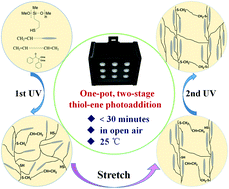A room-temperature two-stage thiol–ene photoaddition approach towards monodomain liquid crystalline elastomers†
Abstract
Monodomain liquid crystalline elastomers (LCEs) with anisotropic, loosely crosslinked polymeric matrices have attracted intense scientific attention due to their widespread applications in stimuli-responsive soft actuators. However, traditional synthetic pathways towards monodomain LCEs require complicated procedures, elevated reaction temperatures, and a prolonged preparation time ranging from several hours to even several days. In this manuscript, we report a fast room-temperature one-pot, two-stage thiol–ene photoaddition method to synthesize monodomain polysiloxane-based LCE films. The first stage is a partial thiol–ene photo-crosslinking of poly(3-mercaptopropylmethylsiloxanes) and vinyl-terminated mesogens and crosslinkers in solution, the second stage is a complete thiol–ene photo-crosslinking of the uniaxially-stretched pre-crosslinked LCE film. Starting from mesogenic monomers, the whole preparation process can be finished in less than 30 minutes, and all the preparation experiments are performed at room temperature, in open air. We believe that this facile one-pot, two-stage thiol–ene photoaddition method can open a new route for the fast and robust production of monodomain LCE shape memory materials.



 Please wait while we load your content...
Please wait while we load your content...